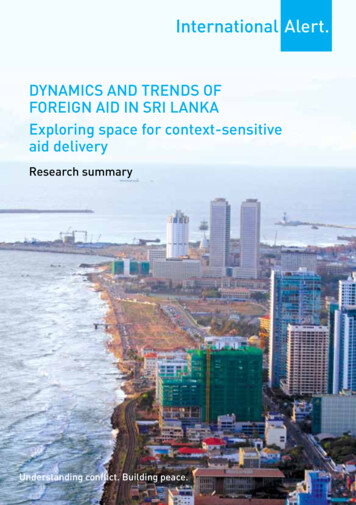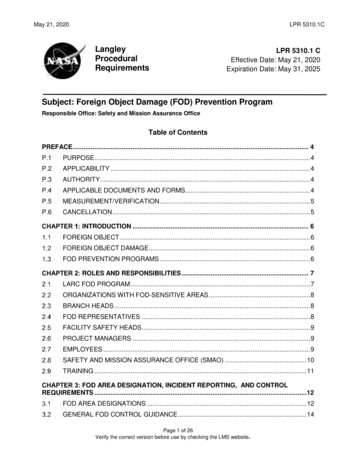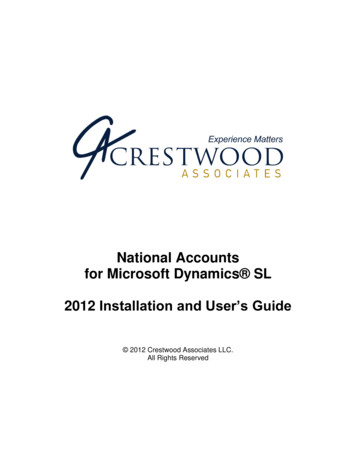
Transcription
DYNAMICS AND TRENDS OFFOREIGN AID IN SRI LANKAExploring space for context-sensitiveaid deliveryResearch summaryUnderstanding conflict. Building peace.
International AlertInternational Alert helps people find peaceful solutions to conflict.We are one of the world’s leading peacebuilding organisations, with nearly 30 years ofexperience laying the foundations for peace.We work with local people around the world to help them build peace. And we advisegovernments, organisations and companies on how to support peace.We focus on issues which influence peace, including governance, economics, genderrelations, social development, climate change, and the role of businesses andinternational organisations in high-risk places.www.international-alert.org International Alert 2013All rights reserved. No part of this publication may be reproduced, stored in a retrieval systemor transmitted in any form or by any means, electronic, mechanical, photocopying, recordingor otherwise, without full attribution.Cover photo Thishya Weragoda. Layout by D. R. ink, www.d-r-ink.com
DYNAMICS AND TRENDS OFFOREIGN AID IN SRI LANKAExploring space forcontext-sensitive aid deliveryResearch summaryDhanusha Amarasinghe and Johann RebertAugust 2013
2 International AlertAcknowledgementsWe wish to extend our sincere gratitude to the external researchers whocontributed to this study: Dr Harini Amarasuriya (Lecturer and socialanthropologist, Department of Social Studies, The Open University of SriLanka) and Dr Dileepa Witharana (Lecturer, Department of Mathematics andPhilosophy of Engineering, The Open University of Sri Lanka) (study topic:‘Dynamics and trends of non-traditional development partner assistance’); DrO.G. Dayaratna Banda (Lecturer, Department of Economics and Statistics,University of Peradeniya) (study topic: ‘Political economy of contemporarySri Lanka’); and Arjuna Seneviratne (Independent Researcher and Head of theAid and Development Effectiveness Programme, The Green Movement of SriLanka Inc.) and Suranjan Kodittuwakku (Former Director to the SustainableEnergy Authority of Sri Lanka, and Chairman and CEO of The GreenMovement of Sri Lanka Inc.) (study topic: ‘Dynamics and trends of traditionaldevelopment partner assistance’). We also express our gratitude to Phil Vernon(Director of Programmes, International Alert) for his feedback and comments.International Alert is also grateful for the support from our strategic donors:the UK Department for International Development UKAID; the SwedishInternational Development Cooperation Agency; the Dutch Ministry ofForeign Affairs; and the Department of Foreign Affairs and Trade of Ireland.The opinions expressed in this report are solely those of International Alertand do not necessarily reflect the opinions or policies of our donors.
DYNAMICS AND TRENDS OF FOREIGN AID IN SRI LANKA 3ContentsAbbreviations4Executive summary51. Introduction62. Sri Lanka’s contemporary political economy73. Key overarching characteristics and trends of foreign aid post-war94. Summary of key concerns195. Moving forward – Some areas of focus22
4 International AUNHCRUNICEFWFPAsian Development BankAsian Development Fund (ADB)Civil society organisationEuropean Investment BankExternal Resources DepartmentFood and Agriculture Organization of the United NationsFragile and conflict-affected situationsForeign development financeForeign direct investmentInternational Bank for Reconstruction and DevelopmentInternational Development Association (World Bank)International development banksInternational Fund for Agricultural DevelopmentInternational Monetary FundJapan Bank for International CooperationLessons Learnt and Reconciliation CommitteeLiberation Tigers of Tamil EelamNordic Development FundOrganisation for Economic Cooperation and Development –Development Assistance CommitteeUnited Nations Development Assistance FrameworkUnited Nations Development ProgrammeUnited Nations Population FundUnited Nations Refugee AgencyUnited Nations Children’s FundWorld Food Programme
DYNAMICS AND TRENDS OF FOREIGN AID IN SRI LANKA 5Executive summaryThe post-war political economy of Sri Lanka is defined by the three-decadelong conflict. The influence of government remains central to the economy, andis increasingly driven by a new bureaucratic class that encompasses the wellconnected social, political and economic elite.The contribution of aid from traditional development partners has decreasedsince 2009, and a strong government-led development policy has determined theirengagement. In contrast, non-traditional donors have significantly increased theirpresence and support, while international development banks and multilateralagencies have increased their commitments. Although the growing non-traditionalpresence poses a challenge to the consistency of standards and practices, it providesthe government with attractive options for acquiring development finance. Thisshifting aid landscape has significant implications for the political economy. Theincreasing reliance on non-concessionary loans to fund development activity andthe resultant increase in the debt burden risk creating a “vicious cycle of debt”.This has the potential to ultimately fuel social and political unrest, as increasinglychallenging economic conditions could require the government to tighten its beltand prioritise expensive repayments in the future.In this context, identifying and improving the effectiveness of traditional and nontraditional development partner-financed projects is a challenge. There exists a clearneed to improve state–citizen and state–donor consultation to ensure an improvedunderstanding of local needs, local conflict dynamics and emerging risks. This willensure a greater degree of sustainability of long-term development programmes thataddress not only economic, but also other human development goals.This paper suggests that development assistance could be a more effective tool forconsolidating peace in Sri Lanka by: Increasing coordination among traditional and non-traditional internationaldevelopment partners; Encouraging wider citizen participation in development processes; Engaging non-state actors such as civil society organisations (CSOs), tradeunions and business communities; Establishing an early warning process for regular analysis and dissemination ofemerging economic development trends; and Allowing independent structures for evaluation and monitoring of projectprocesses.
6 International Alert1. IntroductionThe end of the war in Sri Lanka in 2009 has impacted significantly on the traditionalaid landscape. For many years, the focus was on responding to development needsin the context of violent conflict. However, in the past four years, the critical needhas been to support economic recovery and rehabilitation of conflict-affected areas,along with a wider focus on economic growth as means to spur reconciliation.Because implications of aid and development in this changing context could havefar-reaching impacts on existing or dormant conflict dynamics, International Alertsought to better understand some of these key trends. Alert was keen to explorethree perspectives, namely: the changing trends of bilateral and multilateral aid; theemergence of non-traditional donors; and the overall model of political economythat is driving economic development. It is important that Sri Lanka’s developmentpartners are aware of, and responsive to, the impact their funding has on thecomplex conflict dynamics in Sri Lanka.Following consultation and review, the initial objective to conduct a comprehensivestudy on aid effectiveness was tempered to first understand the immediate post-warsetting. This is seen as a first step to revive a wider dialogue on context-sensitiveaid over the next year. Information in the three snapshot papers developed thus farwas drawn from primary and secondary sources, interviews, structured discussions,and roundtables and dialogues with international development partners, governmentofficials, retired government officials, academics and citizens at a community level.
DYNAMICS AND TRENDS OF FOREIGN AID IN SRI LANKA 72. Sri Lanka’s contemporary political economyDuring the past three decades, the political economy of the Sri Lankan state wassignificantly influenced by the protracted armed conflict. The response of the postcolonial state to the armed movement of the Liberation Tigers of Tamil Eelam(LTTE) led to the formation of a political and economic system in which variouspower bases were created at the centre and in the periphery. These were formedthrough alliances that included the governing hierarchy and ruling factions at thetop, business communities, government bureaucracy, the military and the mediaas an indispensable requirement for the fight against terrorism. The resultant largepolitico-economic functions of the state resulted in a new interdependent de-factobureaucratic class, which has access to and control of a significant amount of theeconomy’s resources.In the post-war and contemporary political economy, the government’s reach,impact and relevance in the economy appear to be significant. This is due to severalfactors that include: significant state ownership and control of key resources ofthe economy (including public utilities, large industries, major banks, insuranceand other financial institutions, and the retail and wholesale industry); theincreasing reach of the new bureaucratic class into the economic sphere; and thedevelopment of private economic activity that increasingly relies on state patronage.Nevertheless, statistically a state with public spending of less than 25% of grossdomestic product (GDP) is considered to be “free” in terms of the government’sinfluence and impact in state economic activity. Sri Lanka’s public spending as apercentage of GDP has declined from 40% in 1980 to 21% in 2012. Thus, sincethe end of the war the traditional state-capitalist nature of the political economy inSri Lanka has increasingly taken on neo-liberal policies.Increasing centralisation of pro-development institutions – for example, throughthe consolidation of poverty alleviation programmes – increases the dependencyof citizens on the government. Centralised processes that inevitably expand thedistance between citizen and state undermine the need for post-war recovery thatis sensitive to the local context and is responding to emerging post-war dynamics,reconciliation, sustainable peace and sustainable political economy.From an additional perspective, Sri Lanka ranks significantly low for eachqualitative indicator for measuring the “quality of government”, as defined by theWorld Bank (see Table 1). South Korea offers a useful comparison to Sri Lanka, asboth shared a similar economic fortune and ranking in the 1950s. The percentileglobal ranks for Sri Lanka show improvement for 2011 in all indicators.
8 International AlertTable 1: World governance indicators for Sri Lanka and South Korea, 2010IndicatorPercentile rank (0–100)Sri LankaSouth Korea1.Voice and accountability38.869.22.Political stability/absence of violence21.250.03.Government effectiveness49.384.24.Regulatory quality45.578.95.Rule of law52.681.06.Control of corruption40.769.4Note: Zero represents the worst situation and one hundred represents the best situation.Source: World Bank (Extracted September 2012)On the macroeconomic front, successive governments of Sri Lanka have stalledvital economic reforms that sought to reduce state subsidies and bring in greaterfinancial discipline to the government budget. The stalled reforms (which theInternational Monetary Fund (IMF) recently advocated for) impose additionaleconomic burdens on citizens through higher prices of goods (see Table 2), highertaxes, higher cost and low quality of public services delivered, and lower wages(as a result of lower productivity). The increasing economic burden on citizens,especially the poor, could provide fertile ground for exacerbating tensions andtriggering new conflicts.Table 2: Colombo Consumer Price Index movements/inflation, year-to-year (Febto Feb)CCPI ource: Department of Census and Statistics, Sri Lanka (Extracted March 2013)
DYNAMICS AND TRENDS OF FOREIGN AID IN SRI LANKA 93. Key overarching characteristics and trends of foreignaid post-warDevelopment finance flowing into Sri Lanka is from traditional donors,1 nontraditional donors,2 quasi-governmental organisations (e.g. export credit agencies),and through sovereign bond sales. Since the end of the war in 2009, non-traditionaldevelopment partner financial disbursements have increased from 9.32% to10.56%, quasi-government and sovereign bond sales have risen from 41.93%to 60.14%, and traditional development partners’ finances have decreased fromaround 48.76% to 29.30% (2009/2012) of all foreign development finance (FDF)disbursements in Sri Lanka (Table 3).Table 3: Total disbursements by borrowing (US million)2009201020112012Non-traditional donors185.1176.4269.9359.4Export credit, Bonds, etc.833.01,957.01,595.02,046.4Traditional ,403.6Total development financeNote: Decimal figures are rounded to the closest 0.1Source: External Resource Department, Government of Sri Lanka, 2009–2012Diminishing presence of traditional bilateral development partnersAt present, there are definite “wait-and-see” policies on the part of traditional donorswith respect to future funding for Sri Lanka. Relatively small bilateral traditionaldonors are moving away from Sri Lanka and will be less significant in the near future.Some are frustrated with regard to their engagement with the government on increasingthe effectiveness of development activity. This is not only due to the challengingenvironment for engagement, but also because of the government’s gradual movementtowards non-traditional development partners. Significant amounts of traditionalbilateral finance still flow into the Sri Lankan economy through multilateral donorsand international development banks (IDBs), but far less is disbursed bilaterally.12 raditional donors are composed of the founders and members of the Bretten Woods institutions –Ttypically Western (the US, Japan and the EU bloc) and international development banks (IDBs) – whichbelong to the Development Assistance Committee (DAC) of the Organisation for Economic Cooperationand Development (OECD), thereby in general referred to as OECD-DAC. Non-traditional donors are the donors that have become global financial powers over the last decade or so.They are typically composed of countries in the Southern Hemisphere and their relevance in the global aidlandscape is perceived to be relatively new and is significantly increasing. Thereby, they are generally knownas “emerging donors”, “new donors”, “new development partners” and “non-DAC donors”. Moreover, theirprocesses of aid distributions are sometimes referred to as “South-South cooperation” by the DAC group.
10 International AlertTable 4: Traditional donor disbursements by agency (US million)DonorADBECEIBFAOGovernment of AustraliaGovernment of DenmarkGovernment of FranceGovernment of GermanyGovernment of JapanGovernment of NetherlandsGovernment of NorwayGovernment of SpainGovernment of SwedenGovernment of SwitzerlandGovernment of the 4.4002.90.90.319.09.9996.7Note: This information could be incomplete, because some donors may not have updated theirinformation with the External Resource Department. Decimal figures are rounded to the closet 0.1.See list of abbreviations at the front of report for the full names of organisations.Source: External Resource Department, Government of Sri Lanka, 2012Increasing non-traditional development partner financesAs the relationship between the government of Sri Lanka and traditional donorsbecomes challenging, there has been a greater reliance on funding from nontraditional development partners that show greater alignment with the Sri Lankangovernment’s own domestic and foreign policy. “Western-based” processes of aid
DYNAMICS AND TRENDS OF FOREIGN AID IN SRI LANKA 11disbursement, effectiveness and engagement are seen as being out of sync withground realities and (Asian) cultural norms. Non-traditional donors, especiallyChina and India, have been crucial allies of Sri Lanka in international andregional politics. They have also both contributed extensively to support postwar development plans of the government (see boxes 1 and 2). Traditionaldevelopment partner measures of effectiveness, driven by the desire for socialjustice, inclusiveness, transparency and accountability, are clearly at odds withregard to policies of non-traditional development partners.Increasing relevance of multilateral agencies and internationaldevelopment banksTrust fund instruments such as the Global Environment Facility (GEF), theMontreal Protocol, the Habitat Conservation Trust Fund (HCTF), etc. wereutilised by some bilateral donors as a means of channelling development fundinginto Sri Lanka. Despite recent political tensions between sections of the UN andthe government, the recently signed UN Development Assistance Framework(UNDAF) for 2013–2017 strikes a positive note in terms of development areasthat are relevant to traditional donor funding. The World Bank and the AsianDevelopment Bank (ADB) seem to have substantive buy-in to the governmentpolicy framework, which includes principles such as delivering early results tobuild public trust and confidence, strengthening institutions in a phased approach,focusing on social accountability, and enhancing political and economic inclusion.Increasing non-concessionary financesThe graduation of Sri Lanka to the status of a middle-income country, with a percapita income of US 2,923 (2012), has begun to close many avenues for obtainingconcessionary loans. European donors no longer provide concessionary loans butlend though export-import banks, where terms are largely market guided. Fundsfrom some UN agencies such as World Food Programme (WFP) are also no longeraccessible unless in very exceptional circumstances (such as natural disasters).Concessional funding from the ADB (Asian Development Fund (ADF)) and theWorld Bank (International Development Association (IDA)) is also on the decline.While the World Bank, for example, sees the need for a set of behavioural andstructural changes – such as realigning public spending and policy in line withSri Lanka’s middle-income status – the situation seems organically to lead to thegovernment exploring other borrowing opportunities without such conditions,and reducing the level of engagement with traditional donors.(Continues on page 16)
12 International AlertBox 1: Snapshot of Chinese development aid in Sri LankaBy 2011, the total amount of development assistance received from Chinaexceeded the total assistance by Japan, traditionally the main provider ofdevelopment assistance for Sri Lanka. The portfolio of development assistancefrom China during 1971–2012 stands at US 5,056 million, of which 94% wasprovided during the last eight years. Chinese commitments have risen from 3%of all foreign assistance in 2002 to 32% in 2012, reaching a peak of 38% in 2011.China has provided soft loans at concessional rates of 2%–3% with maturityterms of 20 years, and 2-5-year grace periods for repayment. However, mostloans are non-concessional or in the form of export credit. For most loans, highinterest rates and strict commercial conditions are common.3 For example,US 306 million for Phase I of the Hambanthota port project is at an interest rateof 6%, with a one-year grace period and a loan repayment period of 11 years.US 891 million has been committed for the Norachcholai Coal Power plant ata 4% interest rate.4 Funding that is being received as grants is provided by thegovernment of China. Some of the typical conditions attached with Chinese loansinclude Chinese companies as project contractors and that priority is usuallygiven to equipment, material, technology or services (at least 50%) from China.5Chinese funds have been utilised mainly for roads and bridges (58%), powergeneration (20%), and ports and aviation (17%). The majority of these loansare from the Export-Import (Exim) Bank of China, the China DevelopmentBank (CDB), and the Industrial and Commercial Bank of China (ICBC). LeadingChinese companies involved in project implementation are the MetallurgicalGroup Corporation, the China Harbour Engineering Company, the SinohydroCorporation, the China National Group Corporation, and the China HuanqiuContracting and Engineering Corporation, with Sri Lankan agent companiesfacilitating operations.Global and regional strategic reasoning behind Chinese development assistanceis oftentimes undeniable. When it comes to Chinese strategic interests in SriLanka, there are several theories that have been articulated by foreign policyobservers. Firstly, with the emergence of China as a global power centre, the3 T. Wheeler et al (2012). China and Conflict-Affected States: Between Principles and Pragmatism – Sri Lanka.London: Saferworld. Available at na%20and%20conflict-affected%20states.pdf4 B. Sirimanna (2011). ‘Chinese and Indian Companies Dominate Sri Lanka’s Mega Project Business’,The Sunday Times (Sri Lanka), 5th September 2010. Available at 1.html5 Ibid.
DYNAMICS AND TRENDS OF FOREIGN AID IN SRI LANKA 13geographic position of Sri Lanka is important to China’s vital trade routes.Secondly, China’s engagement is a tit-for-tat strategy in response to India’sengagement in China’s own South East Asian backyard. Thirdly, it is arguedthat this is a part of China’s “String of Pearls” strategy establishing Chinesenaval bases in Myanmar, Pakistan, Bangladesh and Sri Lanka; and finally thatit is a general gesture of goodwill and building political capital in Sri Lanka.Main Chinese projects67km Navathkuli-Karaitvu-Mannar roadUS million48.4(non-concessional loan, China Development Bank)113km length of Puttalam-Marichchikadde-Mannar road73.2(non-concessional loan, China Development Bank)Southern Expressway from Pinnaduwa-GodagamaMaterial for lighting Sri Lanka Una Province Project138.224.9(Uva Udanaya)Priority road projects II500(non-concessional loan, China Development Bank)Hambanthota Port development306.73(non-concessional loan, Exim Bank)Bunkering facility and tank farm at Hambanthota65.09(non-concessional loan, Exim Bank)Colombo-Katunayake Expressway project248.2(Concessional loan, Exim Bank)Puttalam coal power project – Phase II891(non-concessional loan, Exim Bank)Puttalam coal power project – Phase I455(non-concessional loan, Exim Bank)Mattala Hambanthota international airport190(concessional loan, Exim Bank)13 Diesel engines for Sri Lankan railway100(concessional loan, Exim Bank)National performing arts theatre17(grant, Government of China)Construction of roads10(non-concessional loan, China Development Bank)Reconstruction of BMICH100 Passenger Railway CarriagesColombo Port Terminal Expansion(non-concessional loan)7.227.0350
14 International AlertBox 2: Snapshot of Indian development aid in Sri LankaIndian assistance to Sri Lanka has increased significantly since 2008, but therehas been 40 years of formal development cooperation between the two states.Development assistance from 2008 to 2012 stood at US 1,453 million, of which78% comprised loans and 22% grants.The majority of these loans come from the Exim Bank of India under creditlines. Funding received as grants is provided by the government of India. ManyIndian companies are involved in projects funded by Indian assistance, such asthe construction of railway lines in the Northern province. The management ofthe construction of 12,500 houses in Killinochchi, 12,500 in Mulaithivu, 10,000 inVavuniya, and 15,000 in Jaffna and Mannar is also carried out by Mumbai-basedcompanies. The Indians are mainly involved in railway, power generation, watersupply and importation of capital goods.6India’s economic involvement in Sri Lanka goes beyond development assistance.India is also largely interested in foreign direct investments (FDIs), both in thepublic and private sector. By 2008, 50% of Indian investment in SAARC countrieswas located in Sri Lanka.Some of the main Indian FDI investors Indian National Thermal Power Corporation (NTPC) collaboration withCeylon Electricity Board (CEB) for Sampur 500 MW coal-fuelled plant(US 200 million pledged) Bharti Airtel (US 200 million pledged for 2012) Cairn India in oil exploration in Sri Lanka (approved for US 400 million) ICICI Bank of India Indian Company, L&T in civil construction Power Grid Corporation India Ltd. in collaboration with Lanka Indian OilCorporation Aditya Birla Group (in the process of investing) The Mahindra Group (in the process of investing) HCL (in the process of investing) TATA group (in the process of investing) Lanka Ashok Leyland (in the process of investing)6 B. Sirimanna (2011). Op. cit.
DYNAMICS AND TRENDS OF FOREIGN AID IN SRI LANKA 15Main Indian projectsVocational training centre Vantharamulai, Onthachchimadamand BatticaloaVocational training centre at Nuwara EliyaWomen's trade facilitation and community learning centre,BatticaloaRehabilitation of the Harbour at KankasanthuraiIndian line of creditIndian Dollar Credit Line AgreementUpgrading of Railway Line Colombo-Matara150-bed District HospitalHumanitarian Assistance for Northern and EasternProvincesDe-mining AssistanceTrack laying of Northern Railway LinesUS millionGrant, 3.1Grant, 2Grant, 1.9Grant, 2.225100167.4Grant, 8.3Grant, 9.7Grant, 2.34416.39(India has pledged a credit line of US 800 million for the entire project)Construction of 50,000 houses in North and EastGrant, 300India’s position as a leading member of the Non-Aligned Movement influencesits position on foreign aid. India seeks to promote south-south cooperation andpartnership for mutual benefit based on collective self-reliance. The overall logicthat drives India’s development assistance, however, can be seen as the desire toconsolidate its place as a regional power.In Sri Lanka, India attaches few conditions to grants. A large proportion of its ownloan programme is tied and aid is motivated by its own security priorities, electoralconsiderations in Tamil Nadu, commercial opportunities, and geopolitical concernssurrounding deepening Chinese and Pakistani relations with Sri Lanka.77 Reality of Aid Management Committee (2010). South-South Development Cooperation: A Challenge to theAid System? Available at 3/02/ROA-SSDC-SpecialReportEnglish.pdf
16 International Alert(Continued from page 11)Increasingly diverse options for development financesEven though funding from small traditional bilateral development partnershas been in decline, overall bilateral development assistance (including nontraditional) has expanded. From a decidedly Western-dominated aid landscape,this has changed to include a wider aid community. The expansion and addition ofnew development partners has given the government of Sri Lanka greater leveragewith donors to insist that aid be aligned to national development priorities. Itshould also be noted that significant non-traditional donors such as India andChina are not necessarily or by definition “new donors”. However, their relevanceand importance have changed significantly in the recent past.Lack of consistency within the donor community regardingstandards and practices of aidThe advent of new donors, and their increasing significance, has resulted in a lackof consistency within the overall donor community with regards to standards andpractices of aid delivery and disbursement. While there had earlier been relativelygreater consistency, there are now clear differences with respect to prioritisation ofactivities and implementation methodology between the traditional and emergent bloc.Visible differences remain in strategies for bilateral engagement with the government.Reducing standards of consistency between donors can be a concern due to issuessuch as overlap and duplication of activities, weak planning processes for ensuringsustainability, and inconsistencies in community consultation and participation.The impact of potentially high and increasing indebtednessThe debt service payment forecast is a good indicator to investigate future trendsin the volume of funding and interest rates of donors (Table 5).Table 5: External debt service to GDP (%)External debt serviceto GDP 42.481.701.752.69Source: External Resource Department, 2012It is evident that there is a trend of borrowing more from China, as the debtservice payment (percentage of total bilateral debt) has increased from 4% in 2010
DYNAMICS AND TRENDS OF FOREIGN AID IN SRI LANKA 17to 11% in 2012. The trend is similar for India, with a rise from 3% in 2010 to7% in 2012. This trend towards depending more on non-traditional developmentpartners could potentially and significantly deepen the country’s debt burden.There are indicative signs that Sri Lanka could potentially fall not only into seriousindebtedness, but also into a vicious cycle of debt (see Figure 1).If these trends continue, the government will steer clear of aid from traditionaldonors that have relatively longer approval cycles, controls a
influence and impact in state economic activity. Sri Lanka's public spending as a percentage of GDP has declined from 40% in 1980 to 21% in 2012. Thus, since the end of the war the traditional state-capitalist nature of the political economy in Sri Lanka has increasingly taken on neo-liberal policies.











